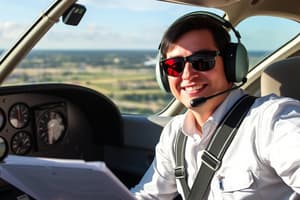Podcast
Questions and Answers
What are the eligibility requirements for a private pilot certificate?
What are the eligibility requirements for a private pilot certificate?
Be at least 17 years of age, able to speak, read, write, and understand English, hold at least a third class medical certificate, receive the required ground and flight training endorsements, meet the applicable aeronautical experience requirements, and pass the required knowledge and practical test.
What privileges may a private pilot exercise? (Select all that apply)
What privileges may a private pilot exercise? (Select all that apply)
- Pay less than the pro rata share of the flight
- Act as PIC of an aircraft (correct)
- Act as PIC for charitable, nonprofit, or community event flight (correct)
- Receive compensation for hire
Name endorsements other than high performance and complex aircraft.
Name endorsements other than high performance and complex aircraft.
High altitude airplane, tailwheel airplane.
What is the definition of a complex airplane?
What is the definition of a complex airplane?
How can one become certified to fly a complex airplane?
How can one become certified to fly a complex airplane?
Define category.
Define category.
What is the definition of class?
What is the definition of class?
What is the definition of type?
What is the definition of type?
What is the difference between current and proficient?
What is the difference between current and proficient?
How do establishing a personal minimums checklist reduce risk?
How do establishing a personal minimums checklist reduce risk?
How long does a pilot have to notify the FAA of their new address?
How long does a pilot have to notify the FAA of their new address?
Can you fly after taking allergy medicine or decongestants?
Can you fly after taking allergy medicine or decongestants?
Where can you find a list of medical conditions that may disqualify you from attaining a medical certificate?
Where can you find a list of medical conditions that may disqualify you from attaining a medical certificate?
What is the difference between standard and special airworthiness certificates?
What is the difference between standard and special airworthiness certificates?
What is an experimental airworthiness certificate?
What is an experimental airworthiness certificate?
How does one determine if an aircraft conforms to its approved type design and is in a safe condition to operate?
How does one determine if an aircraft conforms to its approved type design and is in a safe condition to operate?
What are airworthiness directives?
What are airworthiness directives?
What are the two types of airworthiness directives?
What are the two types of airworthiness directives?
How are special flight permits obtained?
How are special flight permits obtained?
Flashcards are hidden until you start studying
Study Notes
Private Pilot Certificate Eligibility
- Minimum age requirement is 17 years.
- Must be able to speak, read, write, and understand English.
- Requires at least a third-class medical certificate.
- Completion of required ground and flight training endorsements is necessary.
- Must meet applicable aeronautical experience requirements.
- Successful completion of both knowledge and practical tests is required.
Privileges and Limitations of Private Pilots
- Private pilots cannot receive compensation for flying services.
- Act as Pilot In Command (PIC) of an aircraft.
- Must share flight costs proportionally and not pay less than the pro rata share.
- Can serve as PIC for charitable, nonprofit, or community event flights under Part 91.146.
Endorsements for Aircraft Operation
- Additional endorsements available include high altitude and tailwheel aircraft.
Complex Aircraft Definition
- Defined as an aircraft with retractable landing gear, flaps, and a controllable pitch propeller.
Certification for Complex Aircraft
- Must receive logged ground and flight training from an authorized instructor.
- Requires a one-time endorsement in the pilot’s logbook from an authorized instructor.
Aircraft Classifications
- Category: Broad classification of aircraft types such as airplane, rotorcraft, and glider.
- Class: More specific classification within a category, e.g., single-engine land and multi-engine land.
- Type: Specific make and model of aircraft, including modifications that do not alter handling characteristics.
Current vs. Proficient Flying
- Current refers to meeting minimum FAA requirements for a specified period.
- Proficient indicates a pilot’s ability to conduct flights with the necessary knowledge and skills, beyond just legal compliance.
Personal Minimums Checklists
- Pre-established personal minimums aid in making informed go or no-go decisions, enhancing safety.
Address Notification to FAA
- Pilots must notify the FAA of a new address within 30 days of moving.
Medication and Flying Safety
- It is advisable not to fly after taking allergy medicines or decongestants unless cleared by the FAA or a medical examiner.
Disqualifying Medical Conditions
- Standards for medical certification and potential disqualifying conditions are outlined in Part 67 and requirements for obtaining certificates are in Part 61.
Airworthiness Certificates
- Standard Airworthiness Certificate: Issued in white paper for normal, utility, acrobatic, commuter, or transport aircraft.
- Special Airworthiness Certificate: Issued in pink paper for primary, restricted, limited category aircraft, and light sport aircraft.
Experimental Airworthiness Certificate
- Issued for primary category kit-built aircraft constructed without supervision from the production certificate holder.
Aircraft Maintenance and Safety Determination
- Pilots must ensure maintenance, preventive measures, and alterations are performed according to Parts 21, 43, and 91.
- A thorough preflight inspection is required to confirm all structures and instruments are functioning correctly.
Airworthiness Directives (ADs)
- Issued by the FAA to inform about unsafe conditions resulting from design defects or maintenance issues.
Types of Airworthiness Directives
- Divided into two categories: emergency nature ADs requiring immediate compliance and less urgent ADs necessitating compliance within a designated timeframe.
Obtaining Special Flight Permits
- Forms can be acquired from the local Flight Standards District Office (FSDO) or designated airworthiness representative.
Studying That Suits You
Use AI to generate personalized quizzes and flashcards to suit your learning preferences.




